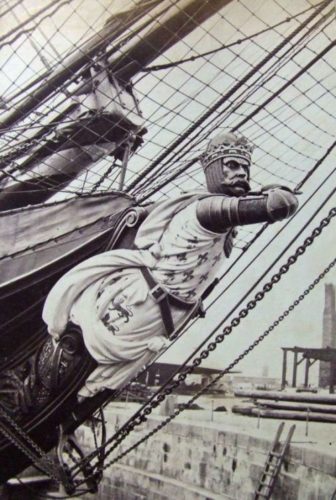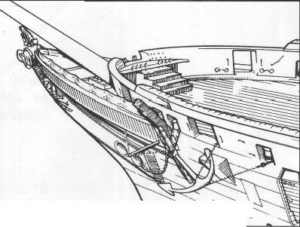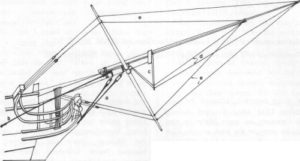- Author
- Nicholls, Bob
- Subjects
- History - general, Ship design and development
- Tags
-
- RAN Ships
- None noted.
- Publication
- September 2002 edition of the Naval Historical Review (all rights reserved)
A figurehead (or more correctly figure head was a carved figure, usually human but quite often animal, fixed to a ship’s stem high in the box, just beneath the bowsprit. It was intended as a decorative emblem expressing either some aspect of a ship’s name or function.
The origin of the figurehead is lost in the mists of antiquity but it is thought to be both religious and personal, at a time when a ship was regarded as a human being.
Eyes were an important part of a figurehead. This was due to the belief that a ship needed to see her way across the seas. This is, or was, a feature of native boats both in the Mediterranean and Asiatic waters. Eyes also played an important part in seeking out shoals of fish. The religious function of the figurehead was due to the need to propitiate the deities of the sea.
Apart from human beings, figureheads could take the form of lions, birds, horses, boats, warriors, swans, dragons and saints.
By the middle of the 19th century female figureheads of both naval and commercial ships gradually became the most popular form of decoration. This is despite the fact that (at that time it must be emphasized!) women were considered to be very unlucky to have on board ship.
Nevertheless, a naked woman – or at least the naked upper half of a woman – was believed to be able to calm storms at sea. This was presumably because the gods of the sea were invariably thought of as being male and therefore could be somewhat charmed and mollified by the sight of a beautiful naked woman.
(However, this explanation is quite at odds with the practice, until changed by political correctness, of awarding typhoons, hurricanes and cyclones with female names.)

HMS Black Prince
The illustration, taken from an early glass plate sepia photograph, is from Britain’s second ironclad frigate.
HMS Black Prince was almost certainly the last British capital ship to carry a figurehead. Her nowadays far more famous sister-ship, Warrior, was the first of this class (of two) to be built.1 She was built by Napiers, of Govan on the River Clyde in Scotland and, on her launch in February 1861, was the largest ship built on that river.
The Figurehead
The ship’s figurehead of the eponymous celebrated prince 2 was 15 feet (5 metres) in length.
The prince is depicted in his historic but unverified black armour with a white and gold mantle.
A drawn sword (or perhaps mace or axe) in his right hand cannot be seen in the illustration.

The figurehead was mounted in the ship’s beak. Above the beak on the upper deck were the crew’s heads. Originally, the men were unprotected from the weather apart from a canvas dodger, but by the time the photograph was taken, perhaps in the early to mid 1870s, this flimsy arrangement had been replaced with a more substantial wooden structure. This is an early instance of pampering to the welfare of the common sailor.
The heel of the bowsprit can be seen at the top of the principal illustration. Some of the standing rigging can be seen below the figurehead.

More details are given in the drawing above, taken from John Harland’s Seamanship in the Age of Sail.
Footnotes
- HMS Rodney, of 1890, was certainly the last British capital ship to carry a figurehead. No satisfactory explanation has ever emerged for the appearance of this absurd anachronism, which occurred thirty years after Black Prince.
- Edward of Woodstock, Prince D’Aquitaine, Prince of Wales, Duke of Cornwall, Earl of Chester and son and heir apparent of Edward III of England. He was one of the outstanding commanders during the Hundred Year’s War, winning a major victory at the battle of Poitiers (1356). It should come as no surprise that his sobriquet, said to have come from his black armour, has no contemporary justification, and appears first two hundred years after his death.
Further Reading:
Admiral G A Ballard, The Black Battlefleet. Nautical Publishing Lymington 1980
John Harland Seamanship in the Age of Sail. Conway London 1985
Peter Jeans Ship to Shore. ABC – CLIO Santa Barbara 1993
Andrew Lambent Warrior. Conway London 1987
Captain H Paasch Illustrated Marine Dictionary. Conway London 1997
Captain John Wells The Immortal Warrior. Mason Emsworth 1984




